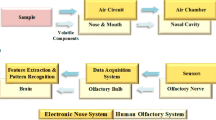Abstract
This paper discusses the design, development and construction of a low cost system to measure plant-based bioactive compounds. The proposed system uses a light emitting diode (LED), an optical filter, a cuvette holder, a photodiode, an electronic board and a mechanical structure. The results are based on transmittance and reflectance absorptiometric measurements. In order to evaluate the sensitivity of the prototype sensor it was tested against a commercial spectrophotometer. The two systems measured the bioactive compounds of a variety of different fruits (acerola, pineapple, plum, atemoya, banana, cashew apple, kiwi, pitomba, sapodilla, yellow mombin and grape). The coefficient r of the two systems were similar (r = 0.99 for total polyphenols, r = 0.95 for total flavonoids, r = 0.99 for ascorbic acid). Nevertheless, further research is required to improve the precision of this optical sensor, which has significant potential for industrial applications.



Similar content being viewed by others
References
A. Brito, J.E. Ramirez, C. Areche, B. Sepúlveda, M.J. Simirgiotis, HPLC-UV-MS profiles of phenolic compounds and antioxidant activity of fruits from three citrus species consumed in Northern Chile. Molecules 19, 17400–17421 (2014)
J.X. Chen, X.F. Wang, Experimental Instruction of Plant Physiology (South China University of Technology Press, Guangzhou, 2002), pp. 125–127. in Chinese
R. Civelli, V. Giovenzana, R. Beghi, E. Naldi, R. Guidetti, R. Oberti, A simplified, light emitting diode (LED) based, modular system to be used for the rapid evaluation of fruit and vegetable quality: development and validation on dye solutions. Sensors 15, 22705–22723 (2015)
V. Edefonti, M. Hashibe, M. Parpinel, F. Turati, D. Serraino, K. Matsuo, Z.F. Zhang, Natural vitamin C intake and the risk of head and neck cancer: a pooled analysis in the International head and neck cancer epidemiology consortium. Int. J. Cancer 137(2), 448–462 (2015)
M. Hasan, T. Bashir, R. Ghosh, S.K. Lee, H. Bae, An overview of LEDs’ effects on the production of bioactive compounds and crop quality. Molecules 22(9), 1420 (2017)
J.A. Larrauri, P. Ruperez, F. Saura-Calixto, Effect of drying temperature on the stability of polyphenols and antioxidant activity of red grape pomace peels. J. Agric. Food Chem. 45, 1390–1393 (1997)
R.H. Liu, Health-promoting components of fruits and vegetables in the diet. Adv. Nutr. 4, 384S–392S (2013)
B. Lorrain, I. Ky, L. Pechemat, P.L. Teissedre, Evolution of analysis of polyphenols from grapes, wines and extracts. Molecules 18, 1076–1100 (2013)
F. Menichini, R. Tundis, M. Bonesi, M.R. Loizzo, F. Conforti, G. Statti, B. De Cindio, P.J. Houghton, F. Menichini, The influence of fruit ripening on the phytochemical content and biological activity of Capsicum chinense Jacq. cv Habanero. Food Chem. 114, 553–560 (2009)
V.M. Moo-Huchin, M.I. Moo-Huchin, R.J. Estrada-León, L. Cuevas-Glory, I.A. Estrada-Mota, E. Ortiz-Vázquez, D. Betancur-Ancona, E. Sauri-Duch, Antioxidant compounds, antioxidant activity and phenolic content in peel from three tropical fruits from Yucatan, Mexico. Food Chem. 166, 17–22 (2015)
M. Obanda, P.O. Owuor, Flavonol composition and caffeine content of green leaf as quality potential indicators of Kenyan black teas. J. Sci. Food Agric. 74, 209–215 (1997)
L.S. Oliveira, C.F.H. Moura, E.S. De Brito, R.V.S. Mamede, M.R.A. Miranda, Antioxidant metabolism during fruit development of different acerola (Malpighia emarginata D.C) clones. J. Agric. Food Chem. 60, 7957–7964 (2012)
A. Oniszczuk, LC-ESI-MS/MS analysis and extraction method of phenolic acids from gluten-free precooked buckwheat pasta. Food Anal. Methods 9, 1–6 (2016)
H. Palafox-Carlos, J.F. Ayala-Zavala, G.A. González-Aguilar, The role of dietary fiber in the bioaccessibility and bioavailability of fruit and vegetable antioxidants. J. Food Sci. 76(1), R6–R15 (2011)
V. Patil, S. Angadi, S. Devdhe, Determination of quercetin by UV spectroscopy as quality control parameter in herbal plant: Cocculus hirsutus. J. Chem. Pharm. Res. 7, 99–104 (2015)
M.S. Pinto, F.M. Lajolo, M.I. Genovese, Bioactive compounds and quantification of total ellagic acid in strawberries (Fragaria x ananassa Duch). Food Chem. 107, 1629–1635 (2008)
L.M. Ramirez-Lopez, A.M. DeWitt, Analysis of phenolic compounds in commercial dried grape pomace by high-performance liquid chromatography electrospray ionization mass spectrometry. Food Sci. Nutr. 2(5), 470–477 (2014)
G. Rateni, P. Dario, F. Cavallo, Smartphone-based food diagnostic technologies: a review. Sensors 17, 1453 (2017)
L.C.R.C. Silva, J.M. David, R.S.Q. Borges, S.L.C. Ferreira, J.P.R. David, R.E. Bruns, Determination of flavanones in orange juices obtained from different sources by HPLC/DAD. J. Anal. Methods Chem. 2014, 1 (2014)
K.O.D. Souza, C.F.H. Moura, E.S.D. De Brito, M.R.A. Miranda, Antioxidant compounds and total antioxidant activity in fruits of acerola from cv. Flor Branca, Florida Sweet and BRS 366. Rev. Bras. Frutic. 36(2), 294–304 (2014)
V. Spínola, E.J. Llorent-Martínez, P.C. Castilho, Determination of vitamin C in foods: current state of method validation. J. Chromatogr. A 1369, 2–17 (2014)
S. Ullah, A. Hussain, J. Ali, K. Ullah, A. Ullah, A simple and rapid HPLC method for analysis of vitamin-C in local packed juices of Pakistan Middle-East. J. Sci. Res. 12(8), 1085–1091 (2012)
Y. Xu, S. Burton, C. Kim, E. Sismour, Phenolic compounds, antioxidant, and antibacterial properties of pomace extracts from four Virginia-grown grape varieties. Food Sci. Nutr. 4(1), 125–133 (2016)
Acknowledgements
The authors would like to acknowledge CNPq (National Council for Scientific and Technological Development), CAPES (Coordination for the Improvement of Higher Education Personnel) and FUNCAP (Ceara State Agency for Technology and Scientific Development) for the providing financial support for this study.
Author information
Authors and Affiliations
Corresponding author
Additional information
Publisher's Note
Springer Nature remains neutral with regard to jurisdictional claims in published maps and institutional affiliations.
Rights and permissions
About this article
Cite this article
Miranda, J.I.S., Lopes, M.M.A., de Souza, K.O. et al. A low-cost optical sensor to quantify bioactive compounds in fruit. Food Measure 14, 3580–3589 (2020). https://doi.org/10.1007/s11694-020-00601-2
Received:
Accepted:
Published:
Issue Date:
DOI: https://doi.org/10.1007/s11694-020-00601-2




